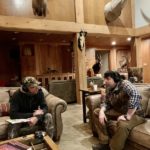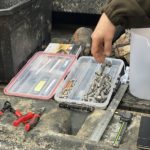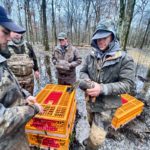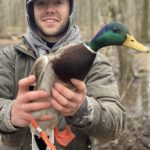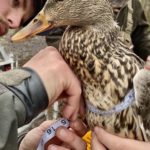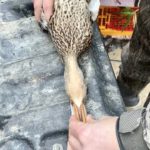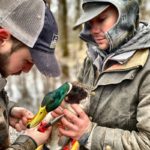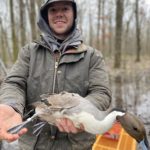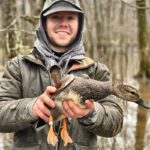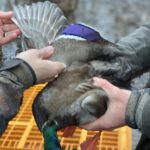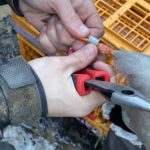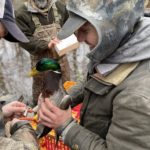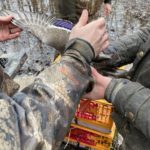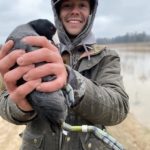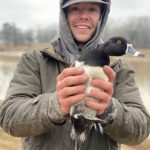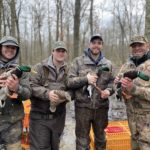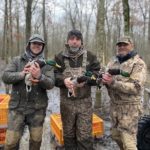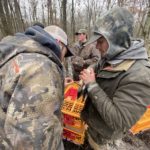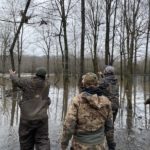Like gleaming gold nuggets to ’49 boomtown miners, waterfowl leg bands are precious commodities coveted by some duck hunters. But to folks like Dr. Doug Osborne, these data points are a bonanza of much needed information. Who is Doug Osborne, and why’d he start The Osborne Lab at University of Arkansas at Monticello? Why is waterfowl banding on the wintering grounds important, and how does it differ from late-summer banding in Canada? How important are mallards to banding programs – and what’s so special about hens? What’re some cool things Osborne has seen along the way? Are flyways shifting westward? Why might we be seeing more ducks after hunting season? Passionate about his waterfowl research, Osborne sheds light on some topics we hunters have been discussing among ourselves for years, and leaves me wondering about a few things that had not yet crossed my mind. Which is the whole point of meaningful research.
Related Links:
Dr. Doug Osborne Uses Waterfowl Banding on Wintering Grounds to Address Important Waterfowl Management Issues and Connect Duck Hunters to Waterfowl Conservation
The waterfowl banding program has given some data. I’m a scientist and we’re always trying to think about what we can do with these. There’s much more to this waterfowl banding program, much more. We take volunteers out, and these are hunters that are passionate about it. I guess what I say is the people, part of this whole thing, the duck hunters getting them out there, getting their kids out there. I have a 10 year old daughter. I love seeing her after holding ducks. The other thing that drives me, the reason I’m in education, period, is because of my students. – Dr. Doug Osborne
Ramsey Russell: Welcome back to Duck Season Somewhere. Man, have I got a great one for you today. There is a massive cold front sweeping across the country right now. I have not seen it this cold or felt this colder during the duck season in a long time down here in Mississippi and Arkansas. This afternoon, Forrest and I drove over to the Arkansas Delta to meet with today’s guest and we’re not hunting geese and we’re not hunting ducks. “Intelligent Tinkering”: a lot of intelligent tinkering goes into viable game populations, into great waterfowl populations. There are a lot of smart people, a lot of volunteers, a lot of effort, and a lot of science that goes into this wonderful resource that we all get to hunt. Today’s guest is Dr. Doug Osborne, the Osborne Lab, the University of Arkansas-Monticello right here in Central Arkansas. Doug, how are you doing today?
Dr. Doug Osborne: I am doing well, thank you so much.
Ramsey Russell: Good. Tell everybody what me and Forrest got to go do today! It’s old hat to you but we had a great time.
Dr. Doug Osborne: The Arkansas season appeared to be a tough hunting season and then the cold front came through and pushed birds here, and I got my waterfowl banding crews out putting bait in the water, and we got traps slam-full of mallard ducks. We are working on a winter waterfowl banding program we’ve been doing for about seven years, and my students are out on about 6, 8, 10 different properties right now trying to catch mallards. The purpose, really, is just to understand distribution patterns and any potential changes in distribution patterns. What can we know? What can we start to learn from these waterfowl bands being put on here? It gives us a good opportunity to get the students out here, get them experience, get these things, and get these guys trained up so we get good waterfowl biologists in the future. We were banding waterfowl and we’re in the middle of it. I think we’re about to get shut down. We’re not in two-inch ice country, but we’re fixing to get two inches of ice.
Ramsey Russell: I believe it. The landowner whose property we trapped this evening was saying it was the coldest, maybe in his lifetime, he’s seen this area.
Dr. Doug Osborne: He grew up on this land.
Ramsey Russell: It’s generational. You can tell with the love and time he put into it. Let’s back up for a minute, Richard. Dadgummit! Y’all, I’ve got a good friend named Richard Osborne and I have called this man Richard about 13 times this evening. Dr. Doug Osborne. Doug?
Dr. Doug Osborne: Yes, sir.
Who is Dr. Doug Osborne, Osborne Labs, University of Arkansas Monticello?
I’ve had a passion for waterfowl all my life…I came to University of Arkansas Monticello with a mission. I told them I’m going to create a waterfowl program here. Arkansas is economically and biologically such an important place for waterfowl, for the people. It’s the culture here and it’s the tradition. – Dr. Doug Osborne
Ramsey Russell: Who are you? You are Richard to me but who are you to everybody else? Tell us a little bit about yourself. I’ve got to hear your story this afternoon. What led you to where you are now? Are you a duck hunter?
Dr. Doug Osborne: I am. I grew up hunting diver ducks really, just a passion for the outdoors. I grew up on a farm; we grew up different than the kids now. We grew up jumping off bales of hay in the barn and driving a truck at 13 years old across the farm. We just grew up different. I grew up walking ditch lines trying to kill pheasants and quail and dragging deer home and duck hunting on the river and so that’s really why I’m here. My passion for the outdoors and in the shooting sports is why and where I’m at, and following a path through life that you just didn’t know where you were going to end up. Getting through high school I had no intentions ever to even go to college. I was that guy who was struggling to get through high school. I was working in a seed corn company, I loved it. I was working hard for the company. I felt like I did a good job for them, they respected me. I felt like it was the best company I ever worked for. I was like, “These guys really, truly care about me.”
One day I was working third shift. I’m climbing in these grain bins, shoveling corn back in the middle so I can get as much of that stuff processed as I can that night so when they come in the next morning that they can start bagging it for seed corn. Working third shift, me and one other guy, for two or three years after high school. I didn’t go to college that way. I’m working in this place, making good money being taken care of. I don’t know what it was, I got smacked in the forehead in the middle of the forehead, third shift in the middle of the night; something just smacked me in the forehead and said “You can’t do this all your life.”
I started community college, right in the town that I grew up in, and it took me three years to get a two year degree. I had no idea what I was going to do. I liked biology classes, so I started saying, “Hey, you need to give me more biology, this is what I like.” I finished up there and took all the classes I could at college and moved on to Western Illinois University in Macomb. I got into the zoology program. I sort of enjoyed it, taking classes. I was doing okay. I wasn’t a great college student. My junior year I decided, “Man, I got to figure life out here.” I applied for a job out in New England, and I said, “I got to get out of here. I’ve never been out of Illinois in my whole life,” so I went and took a job in New Hampshire.
I got set up with some guys, I was living in a house with four or five other guys and they’re out there banding. They’re catching everything in the world they can possibly catch. They wanted to pull blood out of these things. They’re pulling blood out of mergansers and they’re pulling all these golden-eyed birds out of the boxes and I’m like “This is awesome. You can do this for a living for real.” They’re out in the backyard trying to catch bats and woodcocks as they’re doing their spring migration or there’s spring nests and I’m like, “This is unreal.” I came back after that spring experience fired up. You wouldn’t believe it. I could actually get good grades. I came back, finished my bachelor’s degree. I knew exactly what I was doing. The company I work for hired me back the next year and the next year. I came back and I finished my last year of school, straight A’s. I went right into a master’s degree, worked on a master’s project.
Ramsey Russell: With purpose, now.
Dr. Doug Osborne: I knew the purpose. It was on. I worked with common loons up in Voyageurs National Park and International Falls. I understood it. I mean I was going. It was that first job experience [where] I said “This is it.” I finished my Master’s in a year and a half. You don’t do that. Most of my students now, Master’s students, are taking two years, some of them 2 and half, some of them seven, so that’s just the way. I was driven, that’s why I’m where I’m at now because I’ve been driven all my life. I’m not the smartest person out there, I promise you, but I’ll work and get what I want to do. I worked through my Master’s, got my Master’s, and applied for a PhD project. The very first one interviewed for one, I got it. I went to Carbondale for five years, finished a PhD, and here we go.
Ramsey Russell: You were telling me, somewhere along its trajectory from Illinois to here, ended up in Knoxville Tennessee, loved it, your family was doing good, but there weren’t a lot of waterfowl out there.
Dr. Doug Osborne: That’s right.
Ramsey Russell: That’s what led you to Arkansas, that passion for waterfowl?
Dr. Doug Osborne: I’ve had a passion for waterfowl all my life. My PhD was on grassland songbirds and quail. I did some research on management, direct application management. How do we get this CRP back in better condition? I finished up that and then took a post-doc for a year and a half in Knoxville. I loved it, loved life. I was as busy as I’ve been so far in school. I was traveling a lot. Then, post-doc, I knew it was an 18-month job. I started applying for professorships. I got a job. I interviewed and got a job offer in Iowa. I said, man, “Tif and I are an hour or 45 minutes from my parents,” and we’re like, “This is good, real good, this is going to work.” I went out there and I interviewed and I nailed it and they called me up and wanted me to come. I said, “My wife’s not feeling it, we’re not feeling it.” I had a week of a salary left in Tennessee and I turned down a job with a six month old baby. I called my in-laws, and I said, “Y’all better get us a room because I’m not sure if I’m going to have a job lined up here now.” The day after I turned that job down, I got called from Arkansas; they wanted me to come in here in Monticello. It was a month out or so. We made it work for a little bit longer. I found some money at Tennessee; they kept me on for a bid. I interviewed here in Arkansas and they loved it. I came here with a mission. I told them I’m going to create a waterfowl program here. Arkansas is economically and biologically such an important place for waterfowl, for the people. It’s the culture here and it’s the tradition, right?
Ramsey Russell: It’s a duck hunting culture in Arkansas. Arkansas duck hunts are a big thing.
Dr. Doug Osborne: It is a hunting heritage of waterfowl here. I’m thinking, “When you’re a researcher, you have to find a niche.” I’m not going to go to Arkansas to try to do waterfowl research if the best waterfowl research in the world is in Arkansas. How am I going to work with him or compete against him or whatever? I said, “There’s a niche in Arkansas, this is going to work.” I had a passion for it anyway, that’s what I wanted to do. I said, “I’m going to come here and I’m going to create a program. We’re going to focus on waterfowl in this state.” There are a lot of questions that we can answer and that’s what we’ve done. That’s what we’re working on doing.
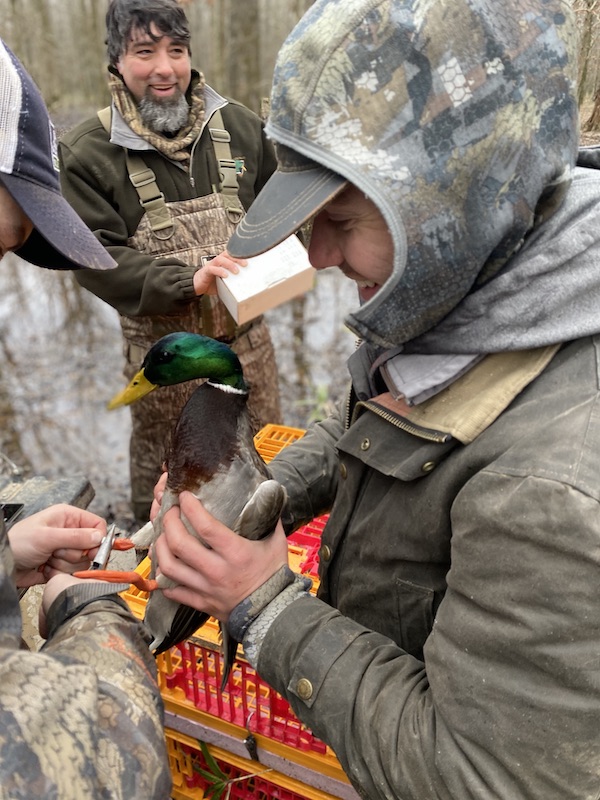
Waterfowl Banding Program and Waterfowl Research
We got people asking lots and lots of questions. The questions that everybody’s answering, the questions that are going to probably drive our hunting regulations in a few years. This hunting pressure thing is going to drive regulations at some point. The timing of migration and distribution is going to drive our hunting regulations at some point. We’re getting ahead of the curve. We’re trying to provide some information on what we can learn from this. This waterfowl banding program is providing us a lot of insight on distributions, timing of migrations. We’re trying to look for changes. – Dr Doug Osborne
Ramsey Russell: Fantastic. Well, what questions are you answering and how are you answering?
Dr. Doug Osborne: I’m interested in the migration stuff. I am interested in applied science. We got people asking lots and lots of questions. The questions that everybody’s answering, the questions that are going to probably drive our hunting regulations in a few years. This hunting pressure thing is going to drive regulations at some point. The timing of migration and distribution is going to drive our hunting regulations at some point. We’re getting ahead of the curve. We’re trying to provide some information on what we can learn from this. This waterfowl banding program is providing us a lot of insight on distributions, timing of migrations. We’re trying to look for changes. Back in the 1960s, the Arkansas Game and Fish Commission banded like 3000 mallards a year in Arkansas for three or four or five years in a row in the ’60s, and then there was a gap, there was no winter waterfowl banding. Then in the ’80s, the Game and Fish Commission stepped up, and they were banding several 1000 mallard a year again. You can pull all this data from the waterfowl banding program. It’s public information, federal data. In the ’80s, they abandoned several thousand a year. Then, there was a big gap again, and nothing. I thought if we band a bunch of waterfowl in Arkansas right now, and we start looking at the timing of their arrival here, their distribution, where they’re harvested, then we can compare to the ’60s and see if we got any kind of changes. What do we see? Is there patterns and stuff that we can tease apart? We compare it to the ’80s. That’s what we’re in the midst of doing. But we were building a relatively long-term data set. We’re 6-7 years into this, now. I think it’s time that we can start teasing apart some of this. I’m working on trying to get the money to hire some students now to start to analyze this data. I think we got a good couple of years. We banded 4000 waterfowl last year.
Ramsey Russell: Wow. Mostly mallards, I know you were telling me out in the field, y’all target now. Not all mallards, but that’s what you’re targeting.
Dr. Doug Osborne: That’s what we’re targeting. We were targeting not because I’m a mallard snob, we’re targeting that because that’s what my research questions. I’m trying to be the most efficient we can in the field to sample the birds that we’re trying to actually analyze. We’re going to band everything we catch. Somebody else, the researchers, policymakers, and managers, are going to potentially use that data down the road, but what we’re looking at using it is mallards.
Ramsey Russell: A mallard is the most ubiquitous duck in the hunter’s bag. Coast-to-coast, north-to-south, mallards. That’s the king of North American birds in terms of a regular hunter. It makes sense that that would be the focus. To me, it does. What do you see now versus the 60s versus the 80s? What are some of these important things that are breaking out, some of this “applied science” stuff you’re saying?
Do migratory waterfowl return to the same areas each winter?
We can’t just focus on a couple of small farms and pieces of land that’s holding a bunch of ducks. That’s not my intention. My intention is to find waterfowl scattered across the southern part of the states, and we banded a good number of ducks in each one of those. We can start to see those Mississippi waterfowl are going to come back to there. How many of those will be harvested at some other sites?
Dr. Doug Osborne: I really haven’t got there, honestly. I think there are changes. I think we got the data now to look at it, and so my next step is getting somebody to start thinking about this. I had a young lady working for me about two years ago that had some extra time, and she really started drilling in this. We’re trying to look at what we can learn about philopatry, and what’s the return rate to the same? What proportion of birds is coming back to the same area? When you say area, how big is that area? Is there a 160 acre block of timber or is it a six county radius area. We’re trying to get at that scale.
Ramsey Russell: What is philopatry? For anybody listening, what is philopatry?
Dr. Doug Osborne: The tendency of these waterfowl to come back to the same area because they’re comfortable with it. You’re going to go to the same restaurant, 3-4 restaurants, because those are your favorite places, you’re familiar with them. We have this understanding that waterfowl probably go back to the same place each year to breed and that sort of thing. Well, do they go to the same field? I bet you they probably do. But it’s a tough question really to put our thumb on and so that’s what we’re kind of looking at with this. We get a lot of birds that are harvested in the same block of woods that we banded them in before and so those are the sorts of things we’re looking at.
Ramsey Russell: It’s extremely important to me, because what you’re explaining is, you would think that birds leave a cohort population, generational, birds that leave a part of Canada come, not just to Arkansas but to a specific property, a specific WMA, a specific river bottom, and that’s what y’all are really trying to key in on.
Dr. Doug Osborne: Exactly. Yeah, we absolutely are. This started a few years ago, small. Ramsey, we’re working on private funding. That’s what the bottom line is boiled down to. I’m working off private funding and I’m expanding. We’re banding waterfowl on 11 sites right now. We’re not on all of them right now because some waterfowl aren’t cooperating and those sorts of things. But I [have] 11 waterfowl banding sites. We have people in Mississippi. I got a text message just a bit ago, they had 75 mallards in the trap. I’m doing my best to get a good distribution across the South, because all the mallards in the world aren’t coming to Arkansas. We’re looking at this whole waterfowl distribution at the population level, the whole group of mid-continent mallards that are coming down the Central Flyway that are wintering in this part of the world. We can’t just focus on a couple of small farms and pieces of land that’s holding a bunch of ducks. That’s not my intention. My intention is to find waterfowl scattered across the southern part of the states, and we banded a good number of ducks in each one of those. We can start to see those Mississippi waterfowl are going to come back to there. How many of those will be harvested at some other sites? It’s going to give us a real good thing. We’re working now. We’ve done a really good job. I’ve got some organizations that have really contributed, and it’s been helping us here in the last two years, and we were able to expand. We’re expanding, especially, to try to get a better representation of the overall population. That’s where we’re at on the banding.
Why is waterfowl banding on wintering grounds important?
Those are data that we rely on for making waterfowl harvest decisions. I think our data the last couple of years for waterfowl banding could potentially be a real good supplement to some of the banding data over the last couple of years because the waterfowl banding programs just didn’t happen on the breeding ground or in those years that they really struggle to catch mallards and mallard band numbers is really what’s giving them the information they need for harvest decisions. I think our waterfowl banding data here is going to supplement that on the population end.
Ramsey Russell: Doug, we all know that they band a lot of ducks and have forever up north in Canada and the Dakotas. Why is it important to band ducks on the wintering ground, and how is it different?
Dr. Doug Osborne: That’s a good question. Historically, the US Fish and Wildlife Service and the state and federal agencies set up waterfowl banding stations and say, “Hey, we got this waterfowl banding data that is going to give us a lot of information on distribution. It’s going to give us information on harvest and survival and all that. This is going to be the data we need to make effective policy and harvest decisions. This is going to tell us how many birds we can harvest. It’s important.” This is back in the 30s.
The Service and the States in the 40s, 50s, 60s are setting up these permanent waterfowl banding stations. We gotta get slap-dab in the middle of the mallards on the breeding ground. That’s the way we’ve got to do it. We’re going to build these permanent waterfowl banding stations, there’s going to be long term data sets. This waterfowl banding data set is, in my opinion, one of the strongest long term datasets we have for waterfowl. We got waterfowl harvest surveys, we’ve got wing surveys, they’re looking at changes in age ratios and sex ratios and harvest and all that. That stuff is really important.
The aerial surveys have been some interesting long term data, too, that’s come and gone and there’s gaps in there, but overall we got two or three pretty decent long term data sets. They’re not perfect. All data has biases, and there are some challenges and limitations to all of our datasets but we only have a few long-term data sets and those are the ones we need to look at change through time. That’s all we have. They banded waterfowl for many, many years up there in Canada, and some years, when they originally started, 90% of the birds they caught were mallards.
Mallards are shifty on the breeding ground just like they are down here. The mallard shift out of the areas that used to be dominated. Now, they’re catching 90% Blue winged teal instead of 90% mallards, but they set these permanent banding stations up so they can’t move. On our end down here, I can move, we can be mobile. That’s why these traps are so small and light. I can roll these things up. A few years ago, I could carry one by myself soaking wet. We can be mobile. I can grab these things and I can be up the road banding on somebody else tomorrow if I need to be. This last year with Covid, a lot of waterfowl banding, we know the BPOP Survey got shut down.
Ramsey Russell: It looks like it’s going to be shut down this year for the second consecutive year.
Dr. Doug Osborne: Those are data that we rely on for making waterfowl harvest decisions. I think our data the last couple of years for waterfowl banding could potentially be a real good supplement to some of the banding data over the last couple of years because the waterfowl banding programs just didn’t happen on the breeding ground or in those years that they really struggle to catch mallards and mallard band numbers is really what’s giving them the information they need for harvest decisions. I think our waterfowl banding data here is going to supplement that on the population end.
Ramsey Russell: You’ve got such mobility and such an opportunity because, especially this time of year in the winter, there are big mallard migrations down here and you can target those mallards. It seemed to me you can have a better catch rate of mallards than maybe they can in permanent stations in Canada and really get that mallard data. I’ve heard that mallard data seems to drive the machine, not just for mallard modeling, but for other species. Mallards are important to North American waterfowl management. There seems to be a lot of advantage to waterfowl banding on the wintering ground versus permanent stations in Canada.
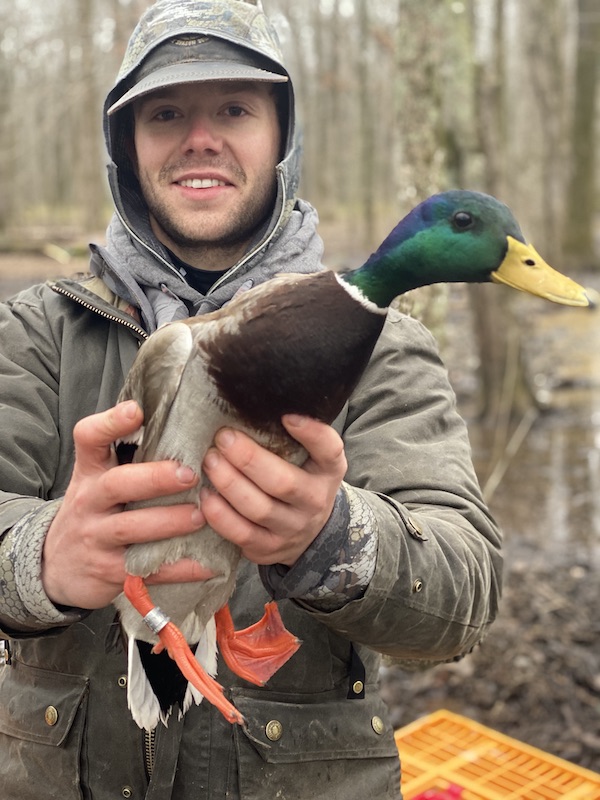
Dr. Doug Osborne: Yeah. Mallard numbers do drive a lot of other species, but we’re getting a better understanding as we talked a bit ago about pintails. Off the record here, but pintails, they’re starting to get some of that modeling down a little bit better. They’re targeting those. They know they need to better their estimates on those. Mallards are important in this situation. We can be mobile, we can be much more efficient. We’ve been catching ducks for six days. We’ve almost caught 3,000 mallards in six days.
Ramsey Russell: My goodness. You were talking about a transition up in Canada from mallards to mostly blue wings. Now, I know when I banded up here in 2001, we caught 7500 ducks and 5800 of them were blue wings. Gosh! 3000 mallards in six days is amazing.
Dr. Doug Osborne: I believe two years ago, during the waterfowl banding on the prairies, they may have caught 4000-5000 mallards during the entire effort across the whole scale. I think it’s a little bit bigger scale here that’s spatially [challenging.] I got a separate, I got to get into Mississippi, I got to get into other northern Arkansas all the way through the Delta. I got to get in the Red River Valley and in southwest Arkansas, we got to get in Louisiana. We got a good partner down there, waterfowl biologist Paul Link catches lots of ducks and white-fronted geese. We need more. We need other states on board. We need other universities to contribute. This is way bigger than me and my students.
Ramsey Russell: That’s a whole lot of digest.
Is the mallard migration shifting west towards the Central Flyway?
If you look at the waterfowl flyways, that’s an administrative line that separates a couple of states. These waterfowl are going to migrate through that region, and they’re going to sample and hit the resources that they need. I think waterfowl have high levels of philopatry. They’re going to come to those same sorts of areas, but there’s things that’s going to get them off track, so I don’t believe there’s any kind of shift. I think there are changes in the timing, in the chronology of their migration.
Ramsey Russell: I have a question for you, true or false, based on your observations and experience down here with mallards in the Deep South. The mallards are shifting west. The mallard migration is shifting drastically west toward the Central Flyway.
Dr. Doug Osborne: I say false.
Ramsey Russell: Why?
Dr. Doug Osborne: We don’t have the waterfowl banding data on this yet. It’s not a shift. Shift’s a tough word. Think about a shift. If you’re going to shift five feet over there, you’re not here anymore. That’s not what we’re seeing. We’re not seeing the population. It’s dynamic. The population has to change. Every year, water is going to be potentially in different areas. You’ve got different amounts of rainfall, the river floods or it doesn’t flood, so the ducks are going to come down here and there’s no water there. They have to go somewhere else. They have to adapt to the changes in the landscape. They’re going to come down here, and there’s an agricultural field that’s been flooded the last couple of years and it’s not flooded this year, so they have to be shifty.
They’re sampling specialists, they have to find food, and that’s dynamic on the landscape. There are so many things, there are hunters everywhere, and so things are going to change. I don’t believe we have the data to say there’s any kind of shift in distribution. I think there are huge changes. I think there are changes in the timing of the waterfowl migration. If you would have asked me two weeks ago, how many ducks we got in the state I would have looked at AGFC’s aerial surveys and say, “I think we’re probably down.” But we caught 800 mallard ducks last night and I’ve seen more mallards today than I’ve seen in a long time. I can promise you this: we are slam-full of mallards, so to tell me that mallard’s don’t go to Arkansas anymore is wrong.
Ramsey Russell: We drove into that first waterfowl banding trap site and the sky was full of ducks, and they were getting out of a slew over there to the left they had not been in yesterday, which we all we’re [saying are] probably new birds just piling in ahead of this front. The weather moves birds, no doubt.
Dr. Doug Osborne: Absolutely. We all know that. Gosh, man, we used to get these arctic fronts. In November, we got that first arctic front across the Great Plains. We didn’t get that this year. Then again in January, you get another one of those. We get a couple of different pushes of ducks. It didn’t happen this year.
Ramsey Russell: It hasn’t happened in a while.
Dr. Doug Osborne: It’s happening now for sure because we’re [about] to be 9 degrees in the next couple of days. I just can’t support the shift west. Do I [have] birds that are banded in Arkansas that are being harvested in Oklahoma? Absolutely. Do I expect anything different? No. Why would I? Just because it’s in the Central Flyway. If you look at the flyaways, that’s an administrative line that separates a couple of states. These waterfowl are going to migrate through that region, and they’re going to sample and hit the resources that they need. I think waterfowl have high levels of philopatry. They’re going to come to those same sorts of areas, but there’s things that’s going to get them off track, so I don’t believe there’s any kind of shift. I think there are changes in the timing, in the chronology of their migration. Yes.
Waterfowl Banding Demonstrates Strong Philopatric Tendencies
“Little Andrew killed a wigeon today that you banded on our property four years ago!” I said, “Where were you hunting?” He said, “We were hunting in the grass.” We caught that wigeon probably seven feet away four years ago. We caught that American wigeon seven feet away from where his son killed it four years later.
Ramsey Russell: Well, speaking of that, this isn’t so much waterfowl banding data, it’s just your working relationship with mallard ducks and migratory birds that are coming down into Arkansas pursuant to banding. You were explaining earlier about these waves of birds. When this cold front hits, lots of birds come down, but there are birds coming down in October and November regardless and you’ve seen that adult mallards are coming down to their old homes. Can you comment on that?
Dr. Doug Osborne: I think our waterfowl banding data has given us some really neat information on that. Hunters educate me, I learn a ton from these guys who have been duck hunting this land for a long time. They say, “Those are our birds, they’re coming in from the west, they always roost over there, they always worked the treetops that same way. I know it’s our ducks.” Then, there are other days that they just act differently, they have to pull them down in a different way, they’re higher, whatever that might be right. These hunters know when it’s their ducks. I feel like our waterfowl banding data is starting to tell us that we have all these little pockets of birds all over the landscape and everybody kind of has their own ducks, and I bet you their ducks are mostly older birds that’ve been coming here for a while, they’re smart as a whip. You can’t kill them but they’re going to be in my trap. We’re catching those things, some 2-3-4 years later. We’re catching them alive with a leg band on that we put on a few years ago. Even the best hunters out there can’t kill them. They’re smart. They’re smarter than we think they are, but they want that corn and they know I’m going to let him go, so they’re okay getting that trap.
Ramsey Russell: That reminds me of a story you told me out there on the levee this afternoon about a landowner’s son shooting a wigeon.
Dr. Doug Osborne: The whole mallard thing, when somebody says, “I killed one of your waterfowl bands in the woods,” the same woods we banded. It doesn’t surprise me a bit. Will Maxwell calls me up on the phone, excited as can be, you can probably feel the energy in my voice, when you talk to Will, he’s got the energy in his voice. I couldn’t even understand him, he’s from South Arkansas. He talks a little differently than I do. He’s going one mile a minute on the phone. I’m like, “Will, I can’t understand what you’re saying”. He said, “Little Andrew killed a wigeon today that you banded on our property four years ago!” I said, “Where were you hunting?” He said, “We were hunting in the grass.” We caught that wigeon probably seven feet away four years ago. We caught that American wigeon seven feet away from where his son killed it 4 years later.
Ramsey Russell: Four years ago, seven feet away.
Dr. Doug Osborne: An American wigeon. We all know about the mallards. It’s amazing.
Ramsey Russell: What are some of the other interesting things you have caught or seen pursuant to this waterfowl banding study? There’s got to be tons, I know you’ve caught hybrids because I follow you on social media.
Dr. Doug Osborne: Lots of interesting things, all the time. Yes, hybrids, old bands, money bands that were relatively old that we’ve caught. We report those. We get a bird already banded. We catch a lot. I bet you we catch a lot more banded birds alive than that landowner on that property actually kills. It’s interesting. We re-catch our own ducks a lot. We really do. Other unique things: abnormal wing colors. Brandon Bennett actually caught a hen mallard with unique white wing patch on this property the other night, and the kids posted that on the Instagram page there the other day. It’s just some neat things that drive a lot of questions. I get text messages at about 11:30 every night of how everybody did. “Look what we caught, what’s this?” they banded it, but we got to kind of figure out what it is. We reported through Bird Banding Laboratory (BBL). Sometimes, there are some things that people don’t even know what they catch.
Hen Mallards Measured While Waterfowl Banding. Why Is Predictive Modeling of Hen Mallards Important?
They have to live through the rest of this winter and they have to be healthy to get to the breeding grounds to be successful, so we’re trying to really pin this down. How much fat are they supposed to have on their body about this time of year? Do you have enough food on the landscape to keep these birds healthy so they can get back to the breeding grounds and produce nests? That’s where we’re looking at.
Ramsey Russell: Changing the subject just a minute, because when we think of waterfowl banding up in Canada, I know that there were a lot of studies way-back-when about migration. Where the birds would go, on how they’re migrating, corridors, flyways, things of that nature. It evolved to whether it’s wood ducks in Mississippi or Canada birds. I know that BBL really does predicate a lot of hunter harvest data, population dynamics, and things like that, but there’s more to that. I noticed we when we caught some of those hen mallards, they didn’t just get age and sex. You did a lot of biometrics on them. Why? What did you do? What biometric did y’all do and why did you do it?
Dr. Doug Osborne: We had a project a couple of years ago, we were measuring some birds from hunters, and we started thinking about what we need. Let me step back. The hens we’re measuring because we’re interested in trying to predict how much fat they have on their body. You think about these migratory ducks, they get down here early, they probably eat a bunch, they put on some extra fat so that when it gets 9 degrees and we get two inches of ice, they can live through it. This week, when it gets to be 9 degrees and we’ve got ice, they’re not going north and there isn’t a whole lot of room to go south, so they need to figure out how to live. They’ve got extra lipids. They have extra fat on their body. They have to live through the rest of this winter and they have to be healthy to get to the breeding grounds to be successful, so we’re trying to really pin this down. How much fat are they supposed to have on their body about this time of year? Do you have enough food on the landscape to keep these birds healthy so they can get back to the breeding grounds and produce nests? That’s where we’re looking at. We found a way to predict how much fat they have on their body. They tell you what the B.M.I score is or whatever. You’re obese, I know I’m obese, everybody is obese. That’s just the way that score works and you’re like…you know what, let me not go there.
Ramsey Russell: But in the wildlife world, fat is good. For a hen mallard, fat is good.
Dr. Doug Osborne: We think so, for survival, but fat is hard to migrate with. It’s hard for these birds to migrate north with extra fat. So where is the balance? How much do they need to get back north, be healthy, and start to build and lay the clutch? I and one of my grad students, Catherine Cody, have found a predictive model to predict how much fat is on these hens. The four metrics that go into that model are what we measured today. We put the soft tape measure around the chest of that bird to measure girth. That’s one of the variables. It’s predictive in our model. We measured these just on the hens today, so that we can come up with an idea. It’s going to give us a scale. We’re going to look at ducks down here and we’re going to look at birds in central Arkansas and the ducks of Mississippi and see if the patterns of this index are different, and they are, because we know there’s more food on the ground in some [of the areas]. You know, food’s not equally laid out in the landscape. There are areas [with] a lot of food and areas [with] a little food. If we find some spatial variation in lipid content of birds right now, maybe we can link that back. There’s lots of other things that go into this, but maybe we can link it back to food on the landscape, and maybe there’s some areas in the region that don’t have enough food and those are ones we can focus on, management-wise.
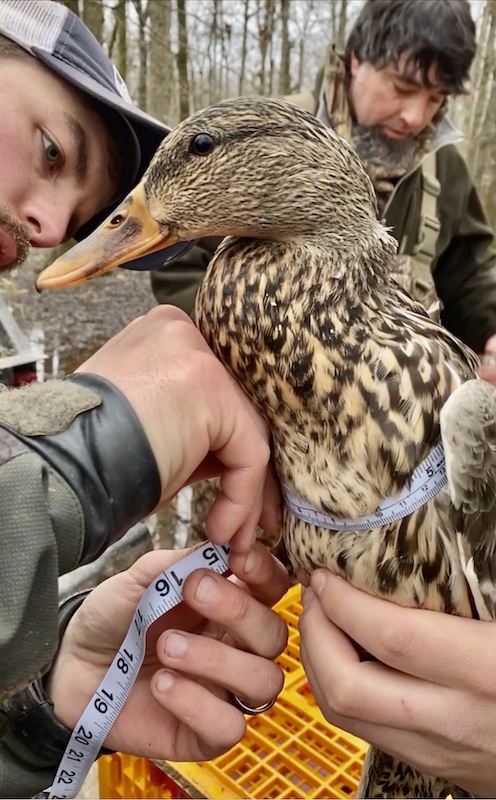
Why Aging Waterfowl While Waterfowl Banding on Wintering Grounds is Important
They band them [up in Canada] and hunting season starts right away. This gives us an idea of survival and gives us a harvest rate. It says, “We harvested 10% of the population as they banded them up there.” But they lose track of those birds because in February we don’t get recoveries. They are banding those birds in August and there’s no more recoveries after February. They’ll catch some more alive on the prairies, but there’s a time from February to August that we’re not sure what survival rate is and I think from my winter banded birds that I can start to get at survival rates, natural survival rates, during that breeding season, during the summer time. That’s just a gap in our understanding. It’s a gap in our knowledge of the life cycle of these birds in survival.
Ramsey Russell: Very interesting. You were also telling me something about how they band birds in Canada. There’s a lot of hatch-year birds, a lot of baby birds getting banded, presumably a lot of those are going to die. They’re young and dumb flying the decoys up north verses winter banded burns down here. I had banded birds way back when, and there were two age classes, hatch-year and adults, but here, y’all did something different. I hadn’t seen it done that way. They may have been hatched this year, but now they’re a young adult. What can y’all find or what are you looking for differently in terms of harvest and survival in filling gaps between Canadian birds that use those banded models versus these on the winter ground?
Dr. Doug Osborne: Pre-season banding is pre-hunting season. The banding that happens after hatch, the birds can’t fly, lots of juveniles, it happens on the prairies. They band them [up in Canada] immediately and hunting season starts right away. They can look at survival rate. This gives us an idea of survival and gives us a harvest rate. It says, “We harvested 10% of the population as they banded them up there.” But they lose track of those birds because in February we don’t get recoveries. They are banding those birds in August and there’s no more recoveries after February. They’ll catch some more alive on the prairies, but there’s a time from February to August that we’re not sure what survival rate is and I think from my winter banded birds I can start to get at survival rates, natural survival rates, during that breeding season, during the summer time. That’s just a gap in our understanding. It’s a gap in our knowledge of the life cycle of these birds in survival, and we know there are predators and there’s other natural mortality that’s happened and we’re trying to get some of that.
Ramsey Russell: I saw firsthand a bird in hand through your eyes or the eyes of your students, aging those birds. How might that quell the myth that, “Hey, all the baby birds are getting shot before they come to the Deep South?”
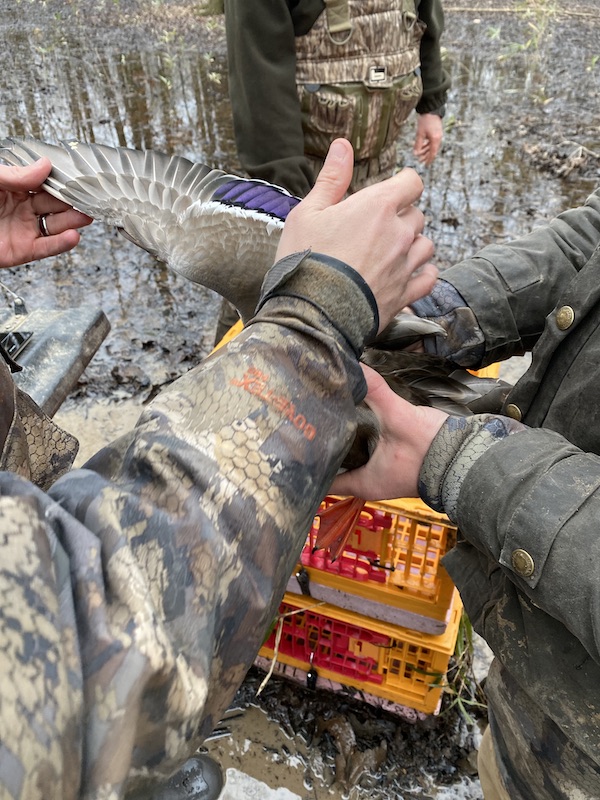
Dr. Doug Osborne: That’s interesting because the best data set I think to start to look at is the Wing Bee. As a duck hunter, the Service calls you and asks you to fill out this sheet and tell [them] every day you hunt and how many birds you harvest. I’m begging the hunters to do it. If they get drawn, it’s supposed to be a random draw, please do this. This is important information. They’re going to ask you what your waterfowl harvest is and it gives them an idea of harvest and then you may get drawn for the wings. They may ask you to clip the dead wing off and send it in, every bird you harvest. As the service gets together and starts to look at those wings, they’re going to tell you that we’re harvesting more of our hatch-year or young birds further north. The further south you get there’s less, they’re more susceptible to the methods and all of that. We’re naturally going to shoot less juveniles down here.
These guys that are shooting mallards at the beginning of hunting season, I can bet your butt most of those are adults. There are ones that probably didn’t breed or are breeding. They were not successful and they left out early. I bet you those younger birds are just staying back. The migration is still real for those birds because they haven’t experienced hunting yet. Those young birds haven’t experienced the hunt. They’re going to get pushed by weather, migration is going to be like a real migration. We’ve got mallards that do a “not-real” migration, if that makes any sense. I’m trying to make sense of my head, it doesn’t make sense but we’ve got mallards that are going to come here in November, it doesn’t matter if the weather pushes them or not. We’re going to shoot less juveniles in the South. Tonight, we caught that pile of mallards in that trap. You see how many hatch-year birds we had. We had a bunch of juveniles. They got pushed down here with this front, they’re still alive. They’re out there.
Ramsey Russell: But to a layman, they’ve got green heads. They’re not looking at some of the upper secondary coverage and some of the details y’all are. To them, It’s an adult bird because it has a big green head.
Dr. Doug Osborne: These ducks are molting all year. You think about the mallard like during migration, and they get down here and they have to start replacing some feathers or getting ready for breeding season. They’re not replacing flight feathers but little ones, these little coverts that are covering them up. We can look at the details, the fine details, on those and identify their age. The difference that you were talking about, their hatch-year versus adult, and now we’re just calling them second-year, is just because of the way that the bird banding lab reports this thing. It’s a calendar year thing so January 1 and all of a sudden it becomes a second-year bird because it’s switching. It was born in August and December, if I would have caught it anytime there, it’s a hatch year, but then January 1 all of a sudden it becomes a second year bird. because it’s by the calendar. That’s what we’re reporting, the second-year birds as we catch them in February. They were born last year. They’re one-year-old birds.
Do waterfowl banding studies support the belief that ducks are migrating South after the season?
Anecdotally, we’ve got ducks that are hunkered down. They’re living all hunting season within a 5 to 8 mile radius of where we caught them…They’re coming off the sanctuary. They’re going into rice fields. I can draw you a triangle where this duck that’s been living since November has been going into three spots over and over and over again…They know where they’re going to live until those guns stop firing…About four or five days after the duck season ends, guess where they’re at? They’re all over the place. The pressure from the hunt, the shotguns going off over and over, and the pressure of the boats.
Ramsey Russell: This major cold front that’s hitting notwithstanding, just wipe it off the table, there’s been a perception for decades that the ducks are showing up later, and I think a lot of that perception is driven by the observation that a week or two after duck season, you go out there and you duck hole and it’s black with ducks. Is that a later migration thing you think? Is it truly a later migration?
Dr. Doug Osborne: Sometimes. This year, probably.
Ramsey Russell: What does it say that ducks are showing up in February? Why do you think it might be that ducks are showing up in February instead of January 15?
Dr. Doug Osborne: We’re doing some research that I haven’t mentioned much of yet. It’s waterfowl satellite transmitters and these things are really interesting. They’ve come a long way, the technology is slightly better now. These things are $1,100 apiece and they collect GPS locations and they store it onboard on a chip and then when this device comes in contact with the cell tower, it just dumps the data, just like a text message, through the cell tower and then I can get it on my phone right now. These things are giving us some neat information here. We can track these things live, nearly. The battery gets worn out in the cold and [there is] no sunshine, they are solar powered and they charge up. We started a study this year. We put a bunch out before the hunting season started. We caught some on private land before the season. We caught some waterfowl on sanctuaries, on refuges, and we’ve just been tracking them. These are just sort of anecdotal things that we’ve caught so far. I have a pile of grad students working on this stuff and doing a great job on it. Anecdotally, though, we’ve got ducks that are hunkered down. They’re living all hunting season within a 5 to 8 mile radius of where we caught them.
Ramsey Russell: Are they exploiting everything within five miles or do they seem to be hopping in specific properties?
Dr. Doug Osborne: Specific spots, over and over.
Ramsey Russell: What might those spots have in common?
Dr. Doug Osborne: They’re coming off the sanctuary. They’re going into rice fields. I can draw you a triangle where this duck that’s been living since November has been going into three spots over and over and over again. You start to think about the spots and you drive to them and you look out there and there’s a duck blind in the middle of the rice field. You’re like, “How’d they not kill this bird yet?” You look at the time in which the bird was on the thing and the thing’s sleeping there every night. I can promise you they eat all the rice out of that field, but they’re not going in there when the hunters are there. These birds are hunkered down.
Ramsey Russell: By hunkered down, you mean hunting pressure, the bomb’s dropping, these things are hunkered down for their lives?
Dr. Doug Osborne: They know how to live. They know where they’re going to live until those guns stop firing. They’re coming off the sanctuary. They’re going into rice fields. I can draw you a triangle where this duck that’s been living since November has been going into three spots over and over and over again. To get to your question, February 10th comes around, and my phone rings off the hook. “Oh we got ducks in our woods. You got to come over here and band them. I haven’t seen this many ducks all year in the woods.” That’s because you’ve been sitting in there shooting at them. They’ve probably been living within five miles of you. Right now, it’s a different story, because we were covered up in birds, but most years, when you don’t get those late winter pushes, those birds are sampling experts. Ramsey, we got mallard ducks that are living in that triangle for 50, 60, or 70 days. About four or five days after the duck season ends, guess where they’re at? They’re all over the place. I have transmitters all over the place right now and they’re not where they were the entire duck season. The pressure from the hunt, the shotguns going off over and over, and the pressure of the boats.
Ramsey Russell: The ATVs and the lights.
Dr. Doug Osborne: And all the little mallard machines that spit whatever they spit everything. They’re adapting to the pressure. They’re rising to the challenge, the populations are going to do fine as long as we don’t drain the prairies and kill the breeding, which is another topic for another day. That topic there, on my opinion, starts to look at carrying capacity, the hens. We said, “Why are there so many drakes? What’s the hen drake ratio looking like? Why is it so heavy drakes?” Some of that stuff may boil down to carrying capacity. How much room capacity can they have for hens to breed when we keep getting rid of more and more wetlands and grasslands? There’s nowhere for them to go.
Ramsey Russell: Now that’s a very sobering thought that you just brought up.
Dr. Doug Osborne: I completely switched gears on that whole deal.
Ramsey Russell: No, that’s good. I mean we’re not just talking about the carrying capacity of the population. We’re talking about those hens, places to nest.
Dr. Doug Osborne: I’m not a geneticist, but maybe, there’s natural selection going on when there’s not enough places to live and to breed. Maybe there’s some sort of selection process in the genes of these ducks. They say that 50-50 out of the egg but I’m not sure. They say that’s what it is. I wonder if it still is.
Ramsey Russell: My understanding from way back when I was your students’ age, and not an old man, was that it takes a lot more energy to make a hen egg than a drake egg, and that the more fit, more lipid, that BMI type stuff you were talking about, the more hen eggs you might be capable of producing. That was my understanding but I don’t know. I love it when my head’s spinning over these good conversations.
Back on hunting pressure, you hear so many people this day and age, especially now that everybody speaks on the cell phone and on social media blare out to the world what their thoughts are. They’re pointing fingers at everybody about why we don’t have ducks. But they’re not pointing fingers at themselves that maybe we’re putting too much freaking hunting pressure on these birds. We travel and we go places. Mexico, you go to Mexico, you don’t see the number of birds in one place that we saw getting off either of those two holes today and all the birds up in the sky, bazillions of them, just this afternoon. They’re coming into water. But the distinction is that those birds are not being hunted for weeks at a time. I can draw a completely unpressured duck that I’ve experienced elsewhere in the world versus 21-22 states hunted this year, pressured birds. Your data and one of the anecdotal stuff you’re seeing shows that.
Is too much hunting pressure affecting duck movement?
We really need to start thinking about this and not drive this thing into the ground. Hunting pressure is real and everybody knows it’s probably an issue, but it’s not their issue, everybody else has to do something different, not them. I think we just need some more data to try to make those good decisions.
Dr. Doug Osborne: These transmitters are really starting to [show that.] To make good decisions, we need to be driven by science, so we’re hoping that this data can provide that insight and potentially change in the future so that we can conserve this resource into the future. We really need to start thinking about this and not drive this thing into the ground. Hunting pressure is real and everybody knows it’s probably an issue, but it’s not their issue, everybody else has to do something different, not them. I think we just need some more data to try to make those good decisions. These transmitters are telling us that these hunting-pressured birds are hunkering down and hunting season opens up and the birds are moving. They’re moving around the landscape. They’ve been feeding in the same fields all year and by the end of January, they’re pretty depleted. The landscape, everything is down here trying to eat all winter, just to live.
All of our ducks are nocturnal. They’re nocturnal when there’s a full moon, but I can tell you that they’re eating a lot at night, full moon or not.
These transmitters are really starting to answer lots of questions. All of our ducks are nocturnal. They’re nocturnal when there’s a full moon, but I can tell you that they’re eating a lot at night, full moon or not. They’re going in these open fields. We have information, we’ve got waterfowl accelerometer data. It’s an interesting piece of data that we’re still trying to figure out. It tells us the sort of angle at which that transmitter is sitting on the duck’s back. If it’s sitting flat, it’s going to give me an XYZ of this. If it’s tipped up and down, it’s going to give me a different read. I can tell you how much proportion of the time that mallards tipped up versus sitting flat versus some other things.
We’re still trying to figure out that accelerometer stuff. It gives us an idea that these ducks are spending a lot of time at night feeding. They’re going into the woods. They’re not going in there to feed, because they’ve been feeding all night. There are food sources and there are acorns and it’s going to give them a good different bit of mineral acids and different things that they’re going to get that they aren’t getting out of other grains, but they are feeding at night. We do see different patterns in nocturnal movements. We know all that stuff starting to come out of this data and so hopefully we can use it. Hopefully, managers can read and policymakers can use this stuff to think about what we can do with regulations so that we can ensure successful hunting moving forward.
How are Osborne Lab waterfowl banding studies being funded?
Ramsey Russell: Absolutely. You said something that I just found so interesting. We’ve been talking for a while about a lot of very valuable information that your research is generating. It’s so valuable that as much as you may be answering, there’s a whole lot more questions beyond that which we’ve been talking about. But one of the things that just strikes me, that slapped me across the face, is the fact that you said something earlier about most of your waterfowl banding research being privately funded by, I’m assuming, landowners, like this right here. Is that what I understood you to say? A lot of it is being privately funded?
Dr. Doug Osborne: Yes, sir. A good bit of it. Even the funding that runs through the non-profit groups that support us. I’ve got Fish and Wildlife Service money. They’re contributing, they’re all interested in these questions. We’re asking the right questions.
Ramsey Russell: Everybody’s on the same team.
Dr. Doug Osborne: We’re not answering those questions at the scale we need to because of where the funding is coming from, because it’s so heavily private. I get lots of requests on Instagram. “How can we help? I don’t have much; I got $25, that’s how I can help you with the banding program.” We’ve created a foundation account at the University of Arkansas main campus in Fayetteville, a waterfowl research foundation account. Folks can donate to that thing and they get tax papers from the University of Tennessee.
Ramsey Russell: We log into a website to help out or how does it work?
Dr. Doug Osborne: We don’t have it set up that way right now. They have to email me osborne@uamont.edu and I will send them a form because the form has two little boxes for you to sign, fill out with your name and address, because the university is going to send you tax papers because it’s a foundation. Anyway, there are ways to contribute and it all helps. It keeps our students busy and it really helps us to keep this stuff going. I’m probably over 70-80 percent privately funded but there are agencies and organizations that we work with that I value their opinion, both on the questions and stuff that they’re looking for us to answer and they contribute as well. There are other universities we are working with. We’re collaborating, we’re dumping data together to answer questions at a bigger scale. We’re done asking questions about this little group of mallards here. We have to look at it at a broader scale. Tennessee Tech University has a really good program as well. They’re putting a couple of hundred transmitters on mallards a year. They’re answering some really good questions. If you think about it, if we get about four states down here and start putting out a couple of hundred transmitters, we can start to really think about some of these things that are on a bigger scale instead of what my little refuge of birds is doing. We’re done with that. We’re beyond that.
Ramsey Russell: The research demands that we scale and do more.
Dr. Doug Osborne: Absolutely. That hit spot-on because we’re managing the midwinter population for some hunters that are passionate about what they do. Landowners like this are putting so much money into their properties and their investments. The public land hunter, like me, is beyond me right now. We’re a little bit worried about the opportunities for public landowners. We have to look at this population as a whole and try to answer some of these bigger scale questions. Changes in distribution? I’m not going to do that by putting 25 transmitters on. We have to mark a good representation of the population, so that’s where I’m screaming for help from some of these other states to get on board.
Ramsey Russell: The reason I brought that up is that we’re all stakeholders, state, federal, NGO individuals. I want to bring the point that these landowners who you’re trapping on are personally benefiting everybody. The guy that’s writing to you on Instagram and contributed 15 bucks, 25 bucks, man, that is a hunter digging in his pocket, again, going to conservation [questions] that we all want answered, for an output that we all want to see the future. That was the only point I was trying to make it is that every time I have conversations with persons like yourself or Paul or anybody else, I marvel at the fact that hunters, in addition to all the excise taxes or the duck stamps, they’re still willing to give what they can because we are stakeholders and we want to see a good result, a greater output. That was the point I was trying to make. I realized we’re all on the same team.
Can we better manage waterfowl hunting pressure?
My role as a scientist is to try to provide you and provide the agencies with the information. This is what the ducks are doing. We think this is how hunting pressures influence that. You all make the decisions.
Ramsey Russell: Forrest just slid a question across the desk and I would like to know your opinion, getting back to hunting pressure. Do you have any thoughts on how we might better manage hunting pressure? Do you have any just personal thoughts on what could be done to mitigate hunting pressure and produce some higher quality hunting experience for everybody, North and South, East and West?
Dr. Doug Osborne: I’m almost going to avoid that. I’m a scientist. I’m trying to let the data tell us what the ducks are doing with hunting pressure.
Ramsey Russell: That’s a very good answer.
Dr. Doug Osborne: My role as a scientist is to try to provide you and provide the agencies with the information. This is what the ducks are doing. We think this is how hunting pressures influence that. You all make the decisions. I’m a scientist, sometimes I get off beat and maybe sometimes I think I get maybe too much inference. “Is the data truly telling me?” and so I always got to kind of reel myself in on this because I get all winded up about this stuff, but I try to stay reeled in, and my answer is that the people that make those decisions, I just hope that they’re using the data that’s available to them to do that, and they do, because I know them. I’m involved with the flyway councils. I go to every February meeting that I possibly can and I listen in on all that stuff. I listen in to the state and federal agency folks that are banging their heads off the wall on a certain thing that they don’t understand why is happening or they’re trying to make some decisions, but they’re thinking about what data they have and what they don’t have to justify that. That’s where I get my research questions because I want to try to provide them with what they need to make those decisions. Those meetings, although I sit back at them a lot of times and don’t say much, but it’s me listening to the aid, to the policy makers, and the guys that are making those regulations. Hopefully, this data can be used by those policy-makers so that we can make the good waterfowl management decisions. Maybe it’s reduced season. Is that a reduced season just here? Do we need to hunt or not hunt Sundays, Mondays, and Tuesdays? We’re banding on a place right now that does not hunt on Monday and Tuesday. They don’t hunt [those] two days.
Ramsey Russell: I’ve seen that out West, out there in the Sacramento Valley, California. Predominantly on state, federal, and a lot of private properties they have what they call “shoot days” on Wednesdays, Saturdays and Sundays.
Dr. Doug Osborne: They don’t hunt during the first split. They just don’t hunt. The seasons come in on November X, and they don’t hunt the first split in the timber. They may hunt them in the field. They don’t get in the timber. Is that them controlling their own pressure? They had a great season this year. I can’t tell you how many birds they caught tonight, but they caught 1,600 mallards in six days.
Ramsey Russell: Those ducks show up and become imprinted on that.
Dr. Doug Osborne: They’re controlling their own pressure and they’re successful and they’re happy. They don’t need to kill 4 mallards a day for 60 days to be happy. They’re controlling their hunt. They’re letting the birds rest. A lot of these guys do this in terms of letting some areas on their property rest to try to leave the birds alone. I don’t know many private landowners that leave any timber for birds to rest in, do you? They let the bean field out there, but that duck needs the bean field and they need the woods and it needs three or four other different types of vegetation cover. It needs a wetland complex and if we’re going to shoot them in every piece of woods in the world that they go into down here, the world as in little South Arkansas world or whatever that might be. I think private landowners asked me, “How do I get consistency in my life?” Maybe that’s it. Maybe you need to control your own pressure. Maybe you need to let those ducks, in some chunks, have some of the woods. That’s an important component of their ecology of that bird, for pair bonding and bugging and getting acorns.
They’re controlling their own duck hunting pressure and they’re successful and they’re happy. They don’t need to kill 4 mallards a day for 60 days to be happy. They’re controlling their hunt. They’re letting the birds rest. A lot of these guys do this in terms of letting some areas on their property rest to try to leave the birds alone.
Ramsey Russell: And just doing ducky things without getting shot at.
Dr. Doug Osborne: Doing ducky things without getting shot at. Maybe, folks that have control of pressure should think about how they can control pressure instead of telling the state agency not to let non-residents come to our state. But you’re going to sit there and shoot ducks in your woods for 60 days? I shouldn’t probably go there and on all that. I understand the pressure.
Ramsey Russell: You’re not saying that’s the way it should be, you’re just saying, “What if?” We’re wrapping up here, but I have to ask you this.
Banded Coots?
Ramsey Russell: I thought Forrest was going to have a heart attack this afternoon, and I had to watch him put that bird on the water to make sure he didn’t stuff it under his coat, take it home, and raise it as a pet. In addition, you’re targeting mallards. We caught pintail, we caught gadwall, and we caught ring-necks, and I’m sure you’ll catch all kinds of stuff, but one lonely old coot got caught up in that trap and y’all banded him, if he gets in trapping band. Close your eyes in envision, the person that’s going to shoot that bird. What’s that phone call? Do you band a lot of coots?
Dr. Doug Osborne: No, we don’t band a lot of coots. We usually mark them. There’s been some interest.
Ramsey Russell: There are people that hunt them.
Dr. Doug Osborne: It’s a hunted species. We band them. Did you get bit? Did it scratch you and about take your eyeball out?
Ramsey Russell: It was as mean as some kind of little dinosaur.
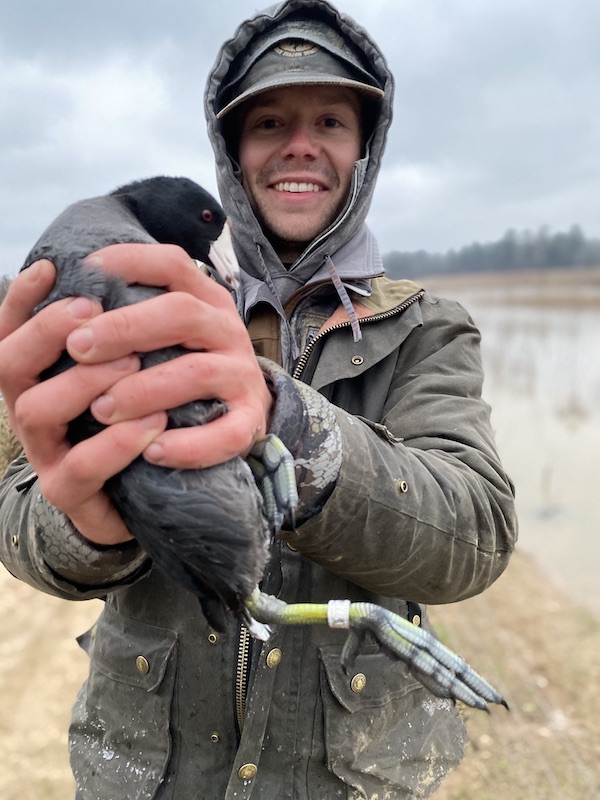
Dr. Doug Osborne: They’re brutal on you, man. I don’t like to get them. The first time we caught them, it was warm, 50 degrees, and they got these waders, and they’re all getting hot and sweaty and taking coats off and they’re rolling their sleeves up because it’s 50 something degrees, and they got 57 coots in their trap and I said, “Put your shirt sleeve down there.” The next thing I know, they come out of there all scratched up from the whole arm, just scratched from the claws on these things. Another neat, funny little story was when I got a new grad student that came in this year and we caught a coot. “I want a coot, I’ve never caught a coot before.” “Go ahead,” I said, “Be careful, it’ll bite you.” She turned that thing to look at her face to face and then, “wham”, that thing bit her on the lips. She’s bleeding. I said, “I told you to be careful.” She gets bit right on the lips. She’ll kick me in the knee if she hears me. I won’t tell her name on here. They’re fun, man.
Read More About Osborne’s Waterfowl Banding: Silver Bands in Green Timber
Why is Waterfowl Banding Personally Important to Dr. Doug Osborne?
We’ve got a neat waterfowl management program here and I think our students are benefiting from it and the duck hunters are benefiting from it. That’s the people part of this thing that I get geared up about.
Dr. Doug Osborne: Let me just say this, I think the waterfowl banding program has given some data. I’m a scientist and we’re always trying to think about what we can do with these. There’s much more to this waterfowl banding program, much more. We’re in the North American Waterfowl Management Plan. How do we manage these that’s in North America at the population level? We’re interested in waterfowl population, we are interested in waterfowl habitat. The other component of this whole thing is people. For me to take you out there today to truly band your first bird, you had pintails, the first pintails you banded. I could see the passion. I could see the excitement on your face from that. I still get excited like that.
We take volunteers out, and these are hunters that are passionate about it, and they continue to pull money out of their pocket. I guess what I say is the people, part of this whole thing, the duck hunters getting them out there, getting their kids out there. I have a 10 year old daughter. I love seeing her after holding ducks. She’s got her favorite species and doesn’t like the mallard because they’re too mean but that’s what drives me. The other thing that drives me, the reason I’m in education, period, is because of these students. I went through college not knowing what I was going to do. I had to find my way. I had some neat mentors along the way, and I finally figured it out.
In hindsight now, I know how to get to where I’m at right now. Before, this was an accident to find my way here just following my path of life. The Good Lord put me into certain places and we did things and we got here. But I feel like I know how to get these students to where they want to go. My question is to them, “What do you want to do? What is your passion, who you want to work for? Can I get you there?” When I can I drag him into the Osborne Lab, that wears me out. I have so much stuff going on but I never turn the students down. I have a hard time just keeping up with things because we have a ton of stuff going on. I still want those kids coming by because I know how to get them to the next step. The experience that they’re getting on this waterfowl banding. They’re learning leadership skills and they got stuff on their CV. They’re going to come out of college with a Bachelor’s degree with some actually real resume stuff on it.
Ramsey Russell: Boots on the ground.
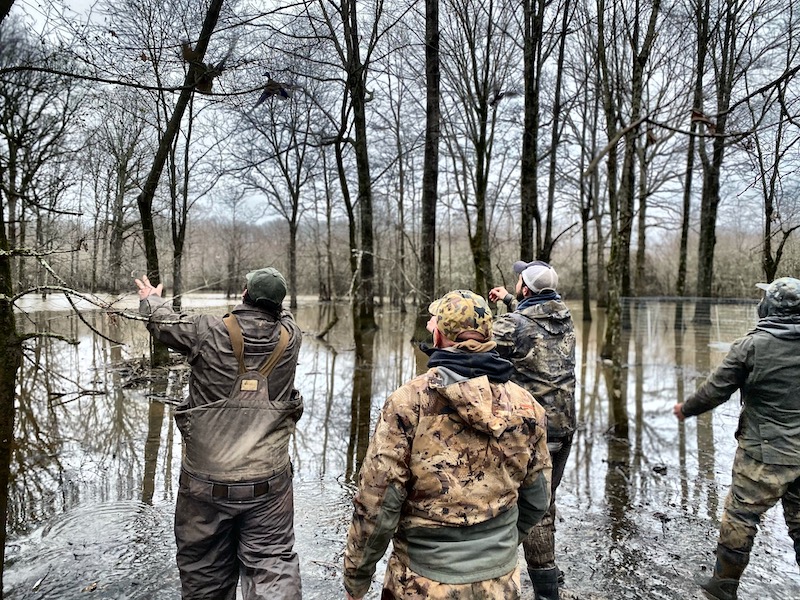
Dr. Doug Osborne: This waterfowl banding project for our students is creating an experience that I think a lot of universities can’t give their students. That’s why I think we’ve got a neat program here and I think our students are benefiting from it and the hunters are benefiting from it. That’s the people part of this thing that I get geared up about. I went into wildlife because I didn’t want to talk to people, and now people are what drives me for what I do. I love the ducks, but these students like getting them, when I get a phone call from Jeremy Ballard and said, “I just accepted a job with “Ducks Unlimited,” that’s what drives me to keep pushing hard. The day my students quit getting jobs in our field and pursuing her passion. I’m walking away from the university.
Ramsey Russell: Amen. Folks, y’all have been listening to Dr. Doug Osborne University of Arkansas-Monticello. How can they connect with you? Everybody wants to jump in and follow this great program. How can folks connect with you?
Dr. Doug Osborne: Instagram @osborne_lab I had a student, a couple of years ago, come to me and say, “I’m creating an Instagram page.” I said, “What’s Instagram? Go ahead. Just don’t get me in trouble.” I can’t work for the federal government. I’d get myself in trouble. Or the state government, but I guess I do work for the state. Anyway, I said, “Just don’t get me in trouble.” Next thing, she says, “We’ve got 3,000 people following us. I’ve been putting pictures of ducks on there” and I said, “Okay.” Here we are, we are doing the best we can to share the knowledge and little bits of information that we can, and so kids are posting maps of their transmitter birds migrating and pictures and just a little information. Osborne Lab, @Osborne_lab, Instagram page was created by our students. It’s pretty much student driven. It’s about them, it’s not about me. I have a job, I love my job. I’m here. I’m doing everything I can to promote them and to keep them active, keep them in this. So, follow us on Instagram and see what the students are doing, and hopefully there’s high school students out there saying, “I want to do this. I want to be a waterfowl biologist.” I hope they enroll in UMA.
Ramsey Russell: We have to fill in all the way over here. Forrest just got out of college. He’s talking about, “I wish I studied ducks. I might have to go back to school.” Now you got him fired up. Gosh, this is such valuable information that we need right now and you’re doing it right. I’ll tell you right now, Doug, you’re doing it right. I’m a diehard follower of the Osborne Lab on Instagram. Folks, again, you’ve been listening to Dr. Doug Osborn, Osborne Lab, University of Arkansas-Monticello. Thank y’all. I hope we answered some questions, and if we didn’t, hit us up in the inbox, hit Doug up, hit me up. We’d be happy to answer more questions. But hey, thank y’all for listening to Duck Season Somewhere. See you next time.




